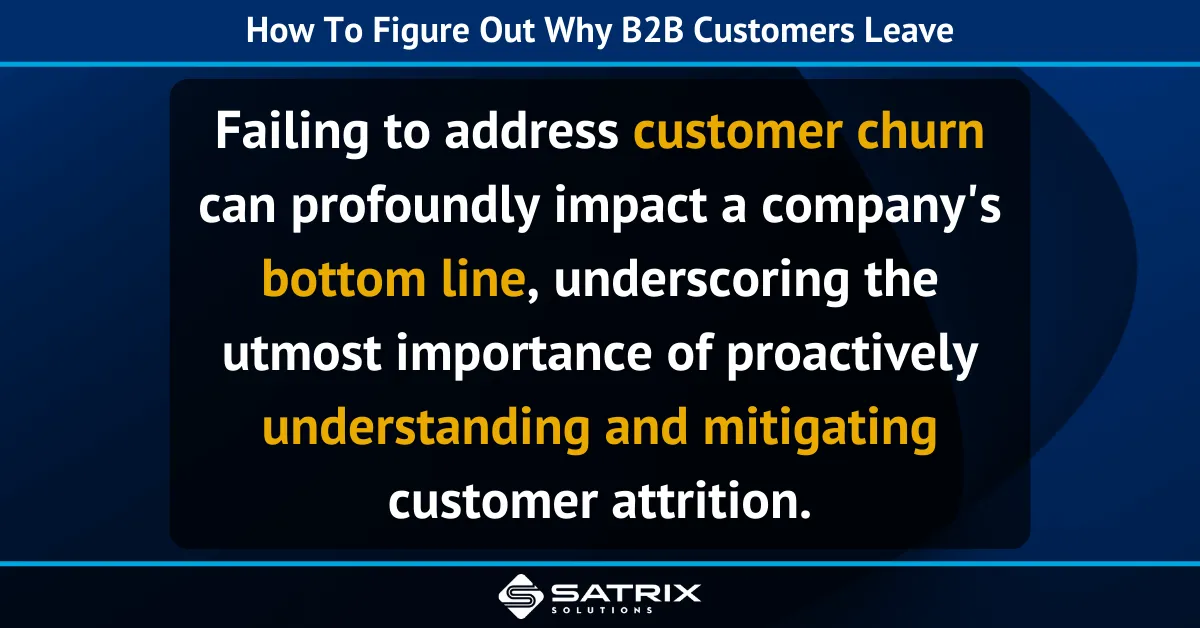Gaining a deep understanding of customer churn in B2B businesses is essential for fostering sustainable growth and ensuring profitability. Businesses can tackle the challenges head-on by identifying the underlying causes and implementing effective retention strategies. Factors such as product dissatisfaction, poor customer service and support, below expected value, limited adoption and usage, and pricing concerns can all contribute to why B2B customers leave. Possessing the ability to grasp these departure reasons empowers businesses to extract valuable insights, enabling them to refine their offerings, enhance customer experiences, and ultimately propel business growth.
Failing to address customer churn can profoundly impact a company's bottom line, underscoring the utmost importance of proactively understanding and mitigating customer attrition. Join us as we delve into the key factors involved in comprehending customer churn and taking proactive steps toward success.
Churn interviews
Third-party churn interviews are widely considered the best approach to gathering valuable insights into why a customer has decided to end the engagement. These interviews offer a direct and semi-structured approach to understanding the factors influencing customer churn decisions. Unlike surveys or analytics data, churn interviews allow businesses to delve into the specific experiences and emotions of the departing customer.
During churn interviews, customers are encouraged to openly express their thoughts and feelings about their overall experience with the company. This candid feedback provides a deeper understanding of pain points, frustrations, and unmet expectations that might have contributed to their departure. By engaging in one-on-one conversations, companies can uncover nuanced reasons for churn that might otherwise be missed in quantitative data. These interviews also help humanize the customer journey, allowing businesses to empathize with their customers' perspectives and foster a sense of trust and rapport.
Furthermore, churn interviews offer a unique opportunity for companies to identify the specific reasons for churn and gather actionable insights for improvement. Armed with this knowledge, businesses can address recurring issues, refine their products or services, and enhance their customer experience to reduce churn rates in the future. By demonstrating a commitment to listening and responding to customer feedback, companies can build stronger, long-lasting relationships with their customer base, leading to increased customer loyalty and retention. Ultimately, churn interviews are a powerful tool in any customer-centric organization's arsenal to continually optimize its offerings and maintain a competitive edge in the market.
Determine Customer Satisfaction and Loyalty Metrics
To understand customer churn, monitoring customer satisfaction and loyalty metrics is another way to watch for warning signals. Metrics like Net Promoter Score® (NPS) and Customer Satisfaction Score (CSAT) provide valuable insights into customer perceptions and their likelihood to continue doing business with you. These metrics help identify potential issues that might drive customer churn, allowing you to take proactive measures to address them.
Analyzing NPS and CSAT scores over time provides trends and patterns that reveal customer sentiment and satisfaction levels. A declining NPS or decreasing CSAT score might indicate underlying issues that are causing customers to leave. By keeping a pulse on these metrics, businesses can take timely actions to improve customer satisfaction and loyalty.
Analyze Customer Usage and Engagement Data
Tracking customer usage and engagement data provides valuable insights into customer churn. Analyzing data patterns and trends throughout the customer lifecycle—from acquisition to attrition—helps identify potential reasons for customer departure. Monitoring metrics such as product usage and feature adoption provides a comprehensive understanding of customer behavior.
For example, declining product usage or low feature adoption may indicate that customers are not fully utilizing the solution or finding value. By closely examining these metrics, businesses can uncover pain points and address them proactively, thereby reducing customer churn.
Review Customer Support Interactions and Feedback
Customer support plays a pivotal role in customer retention. It serves as a direct point of contact for customers when they encounter challenges or have questions about a product or service. When businesses look into customer support interactions and feedback, they can effectively understand and address customer pain points.
Support tickets, emails, and live chat transcripts offer a wealth of information about the challenges customers encounter and their overall experience with the support team. These interactions serve as a compass for identifying recurring issues, bottlenecks, or service gaps that may contribute to customer churn. Understanding these specific pain points empowers businesses to take proactive measures, improve the customer experience, and boost overall satisfaction. It also provides an opportunity to identify areas for training and development within the support team, ensuring they possess the necessary skills and knowledge to meet customer needs effectively.
Analyze Competitor Landscape and Industry Trends
In order to truly grasp the dynamics of customer churn, businesses must broaden their analysis to include the competitive landscape and industry trends. Shifts within the industry, emerging technologies, and evolving customer preferences all have the potential to impact customer satisfaction and loyalty. By remaining attuned to the market, closely monitoring competitor offerings, and understanding industry shifts, businesses gain valuable perspectives that help them uncover potential reasons behind customer attrition.
For instance, if a competitor introduces innovative features or offers more competitive pricing, it may entice customers to switch loyalties. Businesses that adapt to strategies based on these industry insights can proactively address customer needs, stay ahead of the curve, and strengthen their value proposition to mitigate customer churn effectively. Sales Win-Loss interviews are a great way to gather this type of information, as whether your company won or lost a competitive deal, you are likely to learn a lot about the competitive dynamics that contributed to the buyer's decision-making.
Start Retaining B2B Customers Today
Enhancing customer experience is tied to identifying customer challenges. Examining different factors such as customer satisfaction and loyalty, customer user and engagement data, customer support interactions, competitor landscape, and industry trends can strategically implement targeted improvements that directly enhance the customer experience. This, in turn, fosters increased customer satisfaction and loyalty and ultimately drives business growth and profitability.

